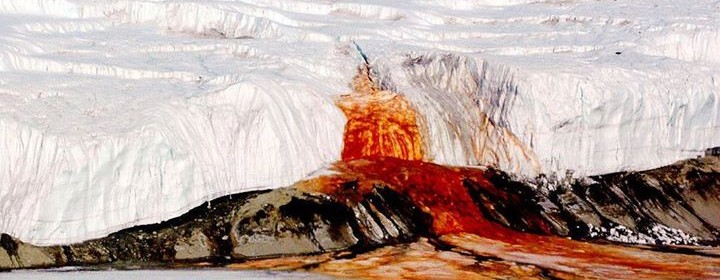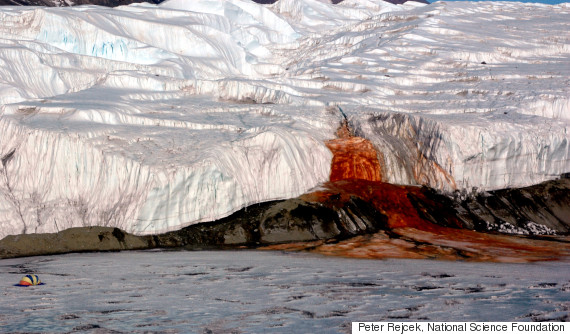Blood Falls: Flowing Network Discovered Below Antarctica’s Dry Valleys

|
Getting your Trinity Audio player ready...
|
One of Antarctica’s most unique features, the briny, rusty-red colored Blood Falls, could possibly even be a doorway into that subterranean world.
The Blood Falls are fittingly named after their blood red color which is actually derived from salt water combined with iron from the bedrock below. As bacteria slowly consume the bedrock, the iron is released. The red color is caused by a chemical reaction with the oxygen in the air when the mixture reaches the surface.
Below you can see the Taylor Glacier where the falls flow into Lake Bonney in one of the Dry Valleys:

Now, for the first time, scientists have been able to trace the water flowing underneath Taylor Glacier to learn more about the mysterious Blood Falls. In the process, the researchers found that the briny water underlies much of Taylor Valley. The subterranean network seems to connect all of the valley’s scattered lakes, revealing that they’re not as isolated as scientists once thought. The findings were published today (April 28) in the journal Nature Communications.
“We’ve learned so much about the dry valleys in Antarctica just by looking at this curiosity,” said lead study author Jill Mikucki, a microbiologist at the University of Tennessee, Knoxville. “Blood Falls is not just an anomaly, it’s a portal to this sub-glacial world.”
An international research team led by Mikucki tested a newly developed airborne electromagnetic sensor in Taylor Valley. The airborne instrument is a large, six-sided transmitter suspended beneath a helicopter which creates a magnetic field that picks up conductivity differences in the ground to a depth of about 1,000 feet (300 meters).
“Salty water shone like a beacon,” Mikucki said.
The researchers found liquid water below the frozen surface in Taylor Valley, stretching from the coast to at least 7.5 miles (12 kilometers) inland. Scientists reported that the water is twice as salty as seawater. Researchers also pointed out that there is also briny water underneath Taylor Glacier as far back as the instrument could detect, about 3 miles (5 km) up the glacier. Eventually, the ice was too thick for the magnetic field to penetrate.
“This study shows Blood Falls isn’t just a weird little seep,” said Mikucki. “It may be representative of a much larger hydrological network.”
There are two possible theories as to how Taylor Valley became so salty: It could be due to the freezing and evaporation of larger lakes that once filled the valley, or it could be possible that ocean water may have once flooded the canyons, leaving remnants behind as it retreated. The new findings will surely assist researchers to narrow down the valley’s aquatic history.
These findings also have scientists considering whether similar subterranean networks of briny groundwater could have formed on Mars when the planet transitioned from having liquid water to a dry environment. “Scientists have been using the Dry Valleys to test instruments since the Viking missions,” Mikucki said. “So how we detect the brines and access them is relevant to work on places like Mars.”
“The subsurface is actually pretty attractive when you think about life on other planets. It’s cold and dark and has all these strikes against it, but it’s protected from the harsh environment on the surface,” said Mikucki.

 Print
Print